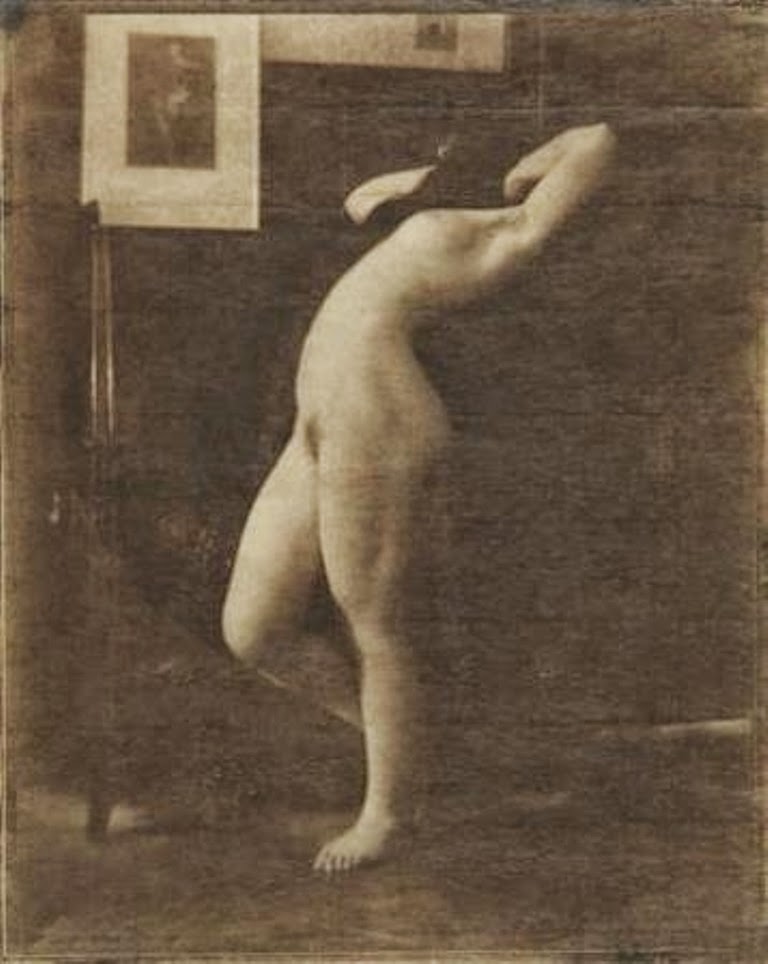Edward Steichen (1879-1973), Heinrich Kühn (1866-1944) and ,
Alfred Steiglitz (1864-1946):
Alfred Steiglitz (1864-1946):
Sculpting the muse(*).
This monumental academic nude is probably the finest photograph in its genre ever taken. I think. I found dates between 1901 and 1904(*). It's a gum-bichromate over platinum print and a study of claire-obscure and of form, created in Paris. Like Auguste Rodin sculpted his models from marble or casted them in bronze, the artist Steichen immortalized his muse with light, a lens, chemicals and many hours spend in a dark room. Both men admired and knew each other closely. It is written(*), somewhere in the Internet, to be his model and lover "Rosa". It is also said(*) that "not long after her posing she committed suicide". Steichen married Clara Smith in 1903(*).
Steichen like the other great pioneers of early photography truly tried to paint with light captured on glas negatives and in the best academic tradition of painters-in-oil of the generations before. His "old master" self-portraits captured on glass above. Rodin, Matisse and all the great "classic" painters embracing these pioneers and the new and magic possibilities of capturing light and images the photographical way.
But then there are these images (c.1908(*), evenly great classical studies, by friend and colleague Heinrich Kühn.
The resemblance of the model, the very long hair and the curves of the beautiful body are at least remarkable although both artists did their best working the negatives and staging the poses to make the women less or not directly recognizable. By face that is. Kühns model is the (English(*) nanny Mary Hanna Warner (she died 1933(*), employed for his four children after the death of his wife Emma Rosa Katzung in 1905. Mary appears in many of his iconic autochrome photographs, alone, clothed and along with his children (same dress ? different hat ?)
But for this undressed session she posed against a roll-top desk in a Paris studio. With different attributes on top. And see the light shining underneath the closed door. Kühn also "etched" his self-portrait on a glass plate and his wife Emma in 1900(*).
(*) "All information found in the Internet is at best unreliable".
is the warning to all modern students at the first day of their academic careers and training. This also applies on readers of this Blog of course.
I couldn't help imagining and thinking Alfred Steiglitz (1864-1946), teacher, colleague and friend of Steichen had James McNeill Whistler's (1834-1903) Japanese inspired "Old Battersea Bridge" in mind when he shot his "Going to the start" in 1905. Whistler's, Steichen's and Steiglitz's work could be seen together in 1908 in New york in the National Arts Club "Special exhibition of Contemporary art".
Colleague photographer Gertrude Käsebier-Stanton (1852-1934) left us Steiglitz' painterly portrait (above) and her self-portrait (below). Steiglitz would accumulate even more fame with the intimate images of his undressed muse, painter Georgia O'Keeffe (1887-1986). Those images you can find easily your-self. Steiglitz had married Emmy Obermeyer in 1893, unhappy he divorced her in 1924 marrying his muse a few month later.
(*) Don't forget to check and double check all "facts" mentioned in this Blog !
(*) THE MOUSAI (Muses) were the goddesses of music, song and dance, and the source of inspiration to poets. They were also goddesses of knowledge, who remembered all things that had come to pass.
All pictures (embiggen by mouse-click) borrowed freely from the Internet for friendly, educational and non commercial use only.










%2B.jpg)

















%2B%22Portrait%2Bof%2BAlexandre%2BDumas%2C%2Bpe%CC%80re%22.%2B.jpg)






_by_Matisse.jpg)















